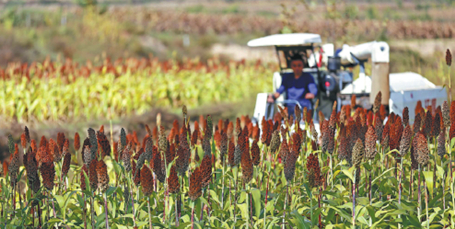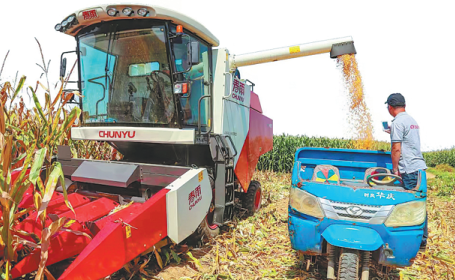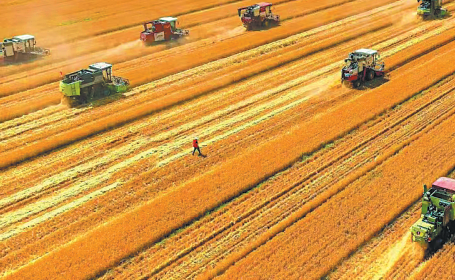Shanxi's grain production hits a record high


Sorghum is harvested on a farm in Shanxi province. [Photo provided to China Daily]
Officials dispatch more than 14,000 agronomists across province during wheat growing season to apply scientific methods
The North China province of Shanxi registered a record output of grains produced in 2023, showing a continued trend of stabilization in agriculture.
Data released by the National Bureau of Statistics on Dec 11 showed that Shanxi's total grain output reached 14.78 million metric tons and its per-hectare yield hit 4.68 tons. Both figures are records in the province.
Shanxi produced 14.5 million tons and 14 million tons of grains in 2022 and 2021 respectively. But local officials said this year's growing output is a hard-won achievement considering the adverse weather conditions.
An agricultural official in Shanxi said that rains fell throughout April and May, posing a serious threat to the growth, harvest and storage of wheat. In July, heavy rains caused by Typhoon Doksuri flooded many farmlands in Shanxi and washed away some newly planted crops.
"Despite all these unfavorable conditions, we still have a better-than-expected harvest for this year," the official said. "It was the good policies, technological advancements and better government services that ensured the growth in output."
The official said the government's favorable policies for farming this year include subsidies for farmland soil improvement, farming machine fuels and fertilizers. There are also government-funded insurances for staple crops such as wheat, corn, potato and soybean.
According to the requirements of the central government, Shanxi planned to develop 123,000 hectares of high-standard farmlands for this year. Under this move, farmers could receive a subsidy of 34,500 yuan ($4,837) for developing one hectare of high-standard farmland.

A combine harvester empties corn into a vehicle in Xijia township, Xiangfen county. [Photo by Chai Xinming for China Daily]
By Dec 8, Shanxi province had more than 140,000 hectares modified into high-standard farmlands, surpassing its annual target.
To date, Shanxi has a total of 1.65 million hectares of high-standard farmlands, which feature high-efficiency, water-conserving irrigation and improved soil conditions.
Along with farmland improvement, Shanxi has used advanced technologies and modernized operations to improve farming efficiency, output and quality.
Local agronomists are contributing their efforts to cultivating advantageous crop varieties, which are conducive to better yield and quality.
According to the Shanxi Department of Agriculture and Rural Affairs, the province currently has 40 breeding and demonstration bases for new crop varieties. These bases have promoted more than 2,400 new, advantageous crop varieties to farmers throughout Shanxi. As a result, about 97 percent of the crops grown in Shanxi fall into the advantageous crop variety categories.
In addition, crop scientists in Shanxi have devoted their energy to field research and technical services, helping farmers grasp new skills for modern operations.
Gao Zhiqiang, a researcher from Shanxi Agricultural University, for instance, has led a team of agronomists from his university to offer technological services to farmers in the county of Yicheng.
During the summer wheat harvest season this year, a farm in Yicheng's Dongguan village – which his team took care of – reported a per-hectare yield of 12.39 tons, breaking the record for wheat farming in Shanxi province.
Gao said the team's bid to improve output is based on data analysis. The scientist said the most effective way to increase output and improve quality is the proper use of water and fertilizers. This can be calculated according to the conditions of the farm, such as soil moisture and the level of nutrition in soil, as well as light and heat exposure.
Dongguan village's record was achieved after wheat growth was affected by such adverse weather conditions as lower temperatures during sowing and continuous rains during the grouting period.
"This shows that a scientific approach to farming can help offset the negative influence of natural uncertainties by working out remedies against such disasters as flood, drought and cold weather," Gao said.
According to Wang Yuanrong, an official at the Shanxi Department of Agriculture and Rural Affairs, the province dispatched more than 14,000 agronomists to the countryside during this year's wheat growing season, offering technical services to farmers.

The mass use of modern farming machines has boosted the efficiency of wheat harvesting in early summer in Shanxi. [Photo by Chai Xinming for China Daily]
The use of modern farming machines is also crucial in ensuring stable farming operations. This was especially true for wheat farming this year, which has featured challenging weather.
The biggest challenge wheat farmers faced was continuous rain during the harvesting season, according to Wang.
"During that critical period for harvesting, weather and efficiency were crucial," Wang said.
He explained that the province became rainy in late May, a time when wheat turns mature and is ready for harvest.
Due to the weather, greater efficiency is needed during harvesting to prevent the grains from going moldy or germinating.
The official said the extensive use of farming machines has played a crucial role in improving efficiency and stabilizing output.
According to Wang, Shanxi has mobilized more than 15,000 combine harvesters and 60,000 tractors for harvesting wheat, with a mechanized harvesting ratio reaching 99.4 percent.
When recalling the summer harvest, Li Guoqiang, a manager of a farming machine cooperative in Yanhu district in the city of Yuncheng, said that it was the extensive use of machines that helped farmers to win "the race against time".
"Our cooperative put all the 27 combine harvesters into operation," Li said. "Those machines worked at an amazing efficiency – completing the harvest of more than 200 hectares on a daily basis."
Wang Xiujuan contributed to this story.
MOST POPULAR
- 1 China to give visa-free treatment to another 9 countries
- 2 China fully opens manufacturing sector to foreign investors in landmark opening up move
- 3 China's import expo attracts record-breaking participating countries, exhibitors
- 4 China's door opening even wider to foreign visitors, businesses
- 5 China revises rules to ease foreign strategic investment in listed firms
Editors' Picks
 Video:
Peru sees new port open
Video:
Peru sees new port open
 Infographic:
China's public holidays for 2025
Infographic:
China's public holidays for 2025
 Infographic:
Basic facts of APEC
Infographic:
Basic facts of APEC
 Infographic:
Wrapping up the 7th CIIE: Data recap
Infographic:
Wrapping up the 7th CIIE: Data recap



